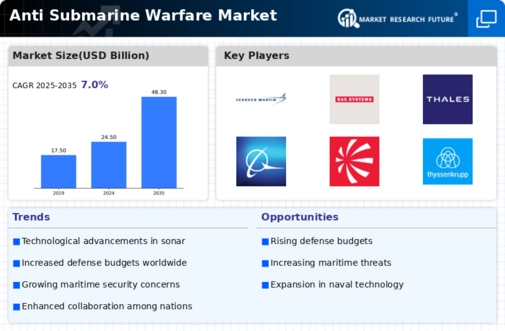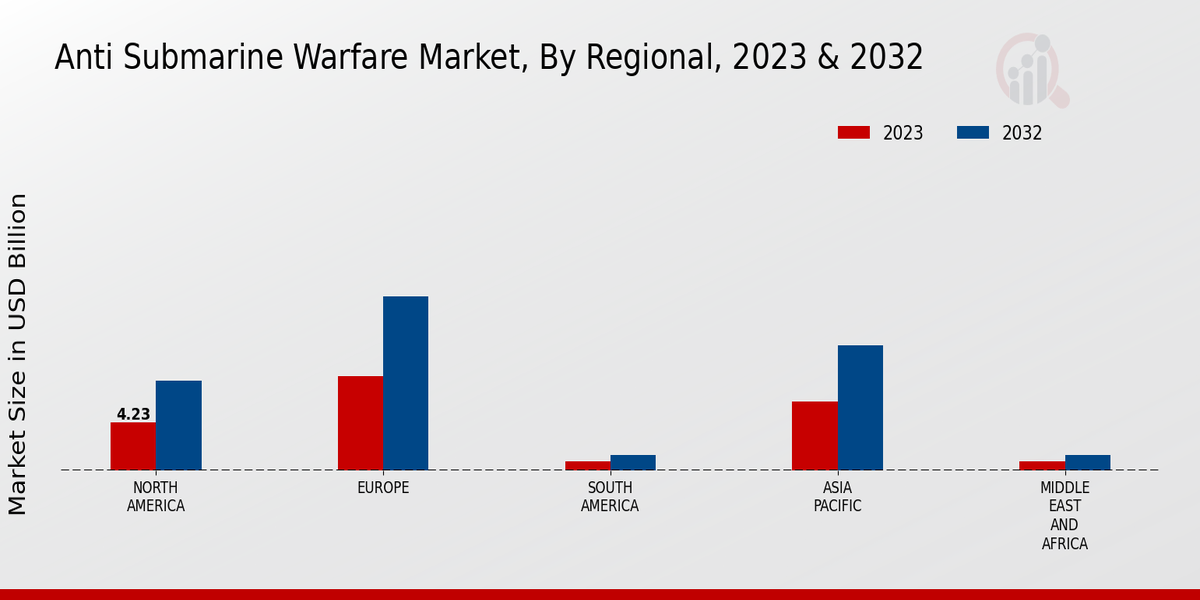Market Growth Projections
The Global Anti Submarine Warfare Market Industry is projected to experience substantial growth in the coming years. With an estimated market value of 24.5 USD Billion in 2024, the industry is on a trajectory to reach approximately 48.3 USD Billion by 2035. This growth is underpinned by a compound annual growth rate (CAGR) of 6.37% from 2025 to 2035, reflecting the increasing demand for advanced anti-submarine warfare technologies and systems. The market's expansion is driven by various factors, including geopolitical tensions, technological advancements, and the need for enhanced maritime security, indicating a robust future for the ASW sector.
Rising Submarine Proliferation
The proliferation of submarines globally is a key driver for the Global Anti Submarine Warfare Market Industry. As more nations acquire advanced submarines, the need for effective ASW systems becomes increasingly critical. Countries such as Russia and North Korea are expanding their submarine fleets, prompting other nations to enhance their anti-submarine capabilities. This arms race in underwater warfare capabilities is likely to stimulate demand for sophisticated ASW technologies, thereby contributing to the market's growth. The increasing focus on submarine detection and neutralization is expected to shape the future landscape of the ASW market.
Increasing Geopolitical Tensions
The Global Anti Submarine Warfare Market Industry is experiencing growth due to rising geopolitical tensions among nations. Countries are investing heavily in naval capabilities to counter potential submarine threats, particularly in strategic regions such as the South China Sea and the Arctic. For instance, nations like the United States and China are enhancing their submarine detection and tracking systems, which contributes to the market's expansion. This heightened focus on anti-submarine warfare capabilities is expected to drive the market to an estimated value of 24.5 USD Billion in 2024, reflecting the urgency of maintaining maritime security.
Enhanced Maritime Security Initiatives
Enhanced maritime security initiatives are propelling the Global Anti Submarine Warfare Market Industry forward. Governments are recognizing the importance of securing vital shipping lanes and protecting economic interests from potential submarine threats. Collaborative efforts among nations, such as joint naval exercises and intelligence sharing, are fostering advancements in ASW strategies. For example, NATO's emphasis on collective defense has led to increased investments in ASW capabilities among member states. This collaborative approach is likely to drive the market's growth as nations prioritize the development of robust anti-submarine warfare systems to safeguard their maritime domains.
Growing Investment in Naval Modernization
The Global Anti Submarine Warfare Market Industry is significantly influenced by the growing investment in naval modernization programs across various countries. Nations are recognizing the need to upgrade their fleets to address evolving threats from advanced submarines. For instance, countries like India and Australia are investing in next-generation submarines and ASW platforms, enhancing their maritime defense capabilities. This trend is expected to propel the market to reach approximately 48.3 USD Billion by 2035, as governments prioritize the modernization of their naval forces to ensure national security and maintain strategic advantages.
Technological Advancements in ASW Systems
Technological advancements play a crucial role in the Global Anti Submarine Warfare Market Industry. Innovations in sonar technology, unmanned underwater vehicles, and artificial intelligence are transforming ASW capabilities. For example, the integration of advanced sonar systems enhances detection ranges and accuracy, allowing for more effective submarine tracking. Additionally, the deployment of autonomous underwater vehicles is revolutionizing surveillance operations. These advancements not only improve operational efficiency but also contribute to the projected market growth, with an anticipated CAGR of 6.37% from 2025 to 2035, indicating a robust future for ASW technologies.






















Leave a Comment